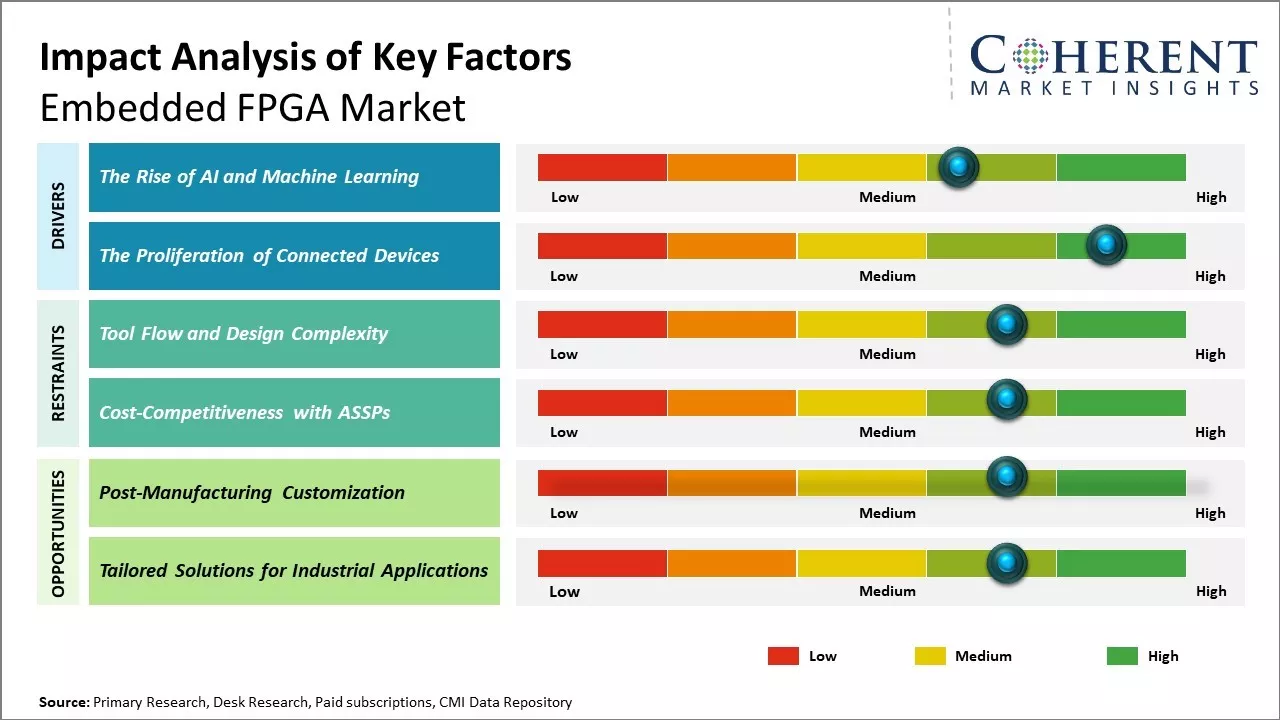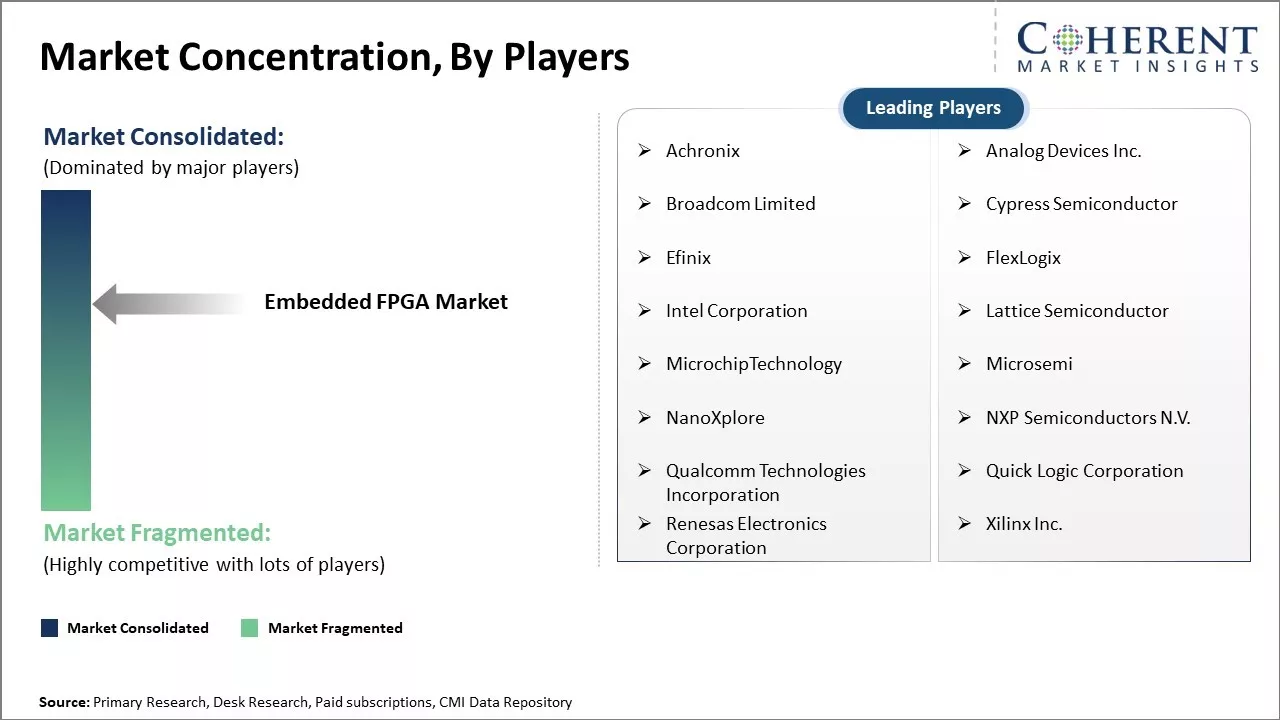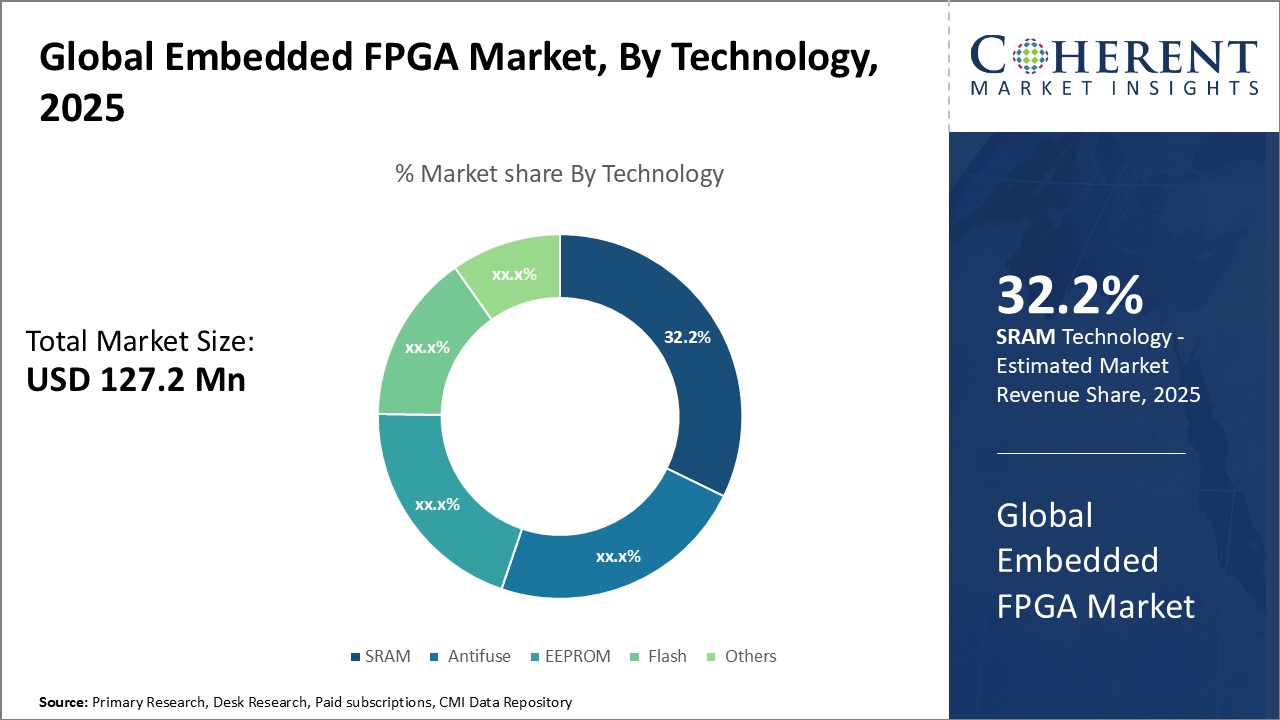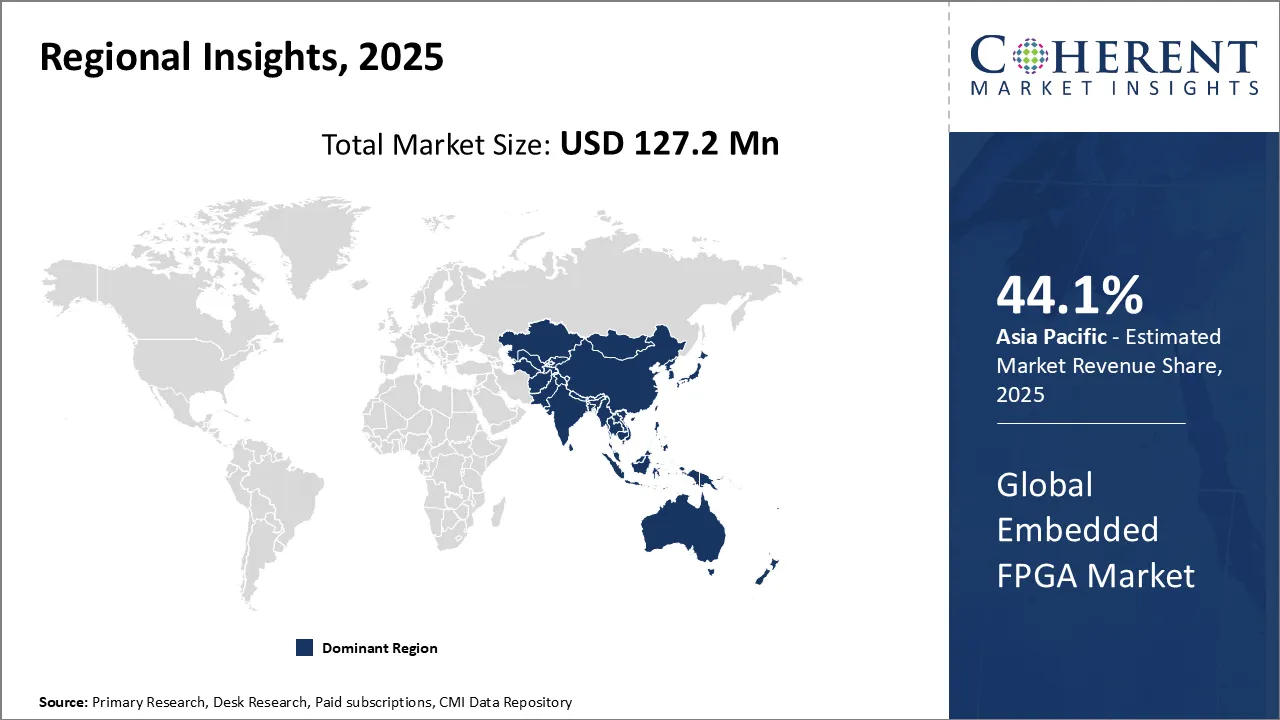Global Embedded FPGA Market Size and Trends
Global embedded FPGA market is estimated to be valued at USD 127.2 million in 2025 and is expected to reach USD 355.3 million by 2032, exhibiting a compound annual growth rate (CAGR) of 15.8% from 2025 to 2032.

Discover market dynamics shaping the industry: Download Free Sample
The market is expected to witness significant growth during the forecast period due to increasing demand for embedded FPGAs across various industry verticals coupled with the growing adoption of system-on-chip designs.
Embedded FPGAs help integrate programmable logic into SoCs along with other components, thereby, providing developers enhanced flexibility to modify hardware designs based on changing application requirements post-production. These also help to streamline development cycles and reduce time-to-market by allowing customizations at the hardware level during product development. Rapid technology shifts and evolving standards across industries are driving the need for more adaptable and reconfigurable devices such as embedded FPGAs. The automotive, industrial and communications sectors in particular are expected to boost adoption of Embedded FPGA during the forecast period.
Rise of AI and Machine Learning
With increasingly complex AI and machine learning workloads, embedded FPGAs are being adopted to efficiently handle these tasks at the edge. As more AI capabilities are integrated directly into edge devices like cameras, routers, and industrial equipment, there is a need for flexible and high-performance computing close to where data is generated and consumed. Embedded FPGAs provide an ideal programmable hardware target for developing and deploying customized AI/ML models directly on edge silicon. Compared to traditional CPU or GPU solutions, FPGAs are better suited to accelerate workloads involving real-time image and video processing, sensor fusion, predictive maintenance, and natural language processing. Leading companies developing AI edge devices are leveraging embedded FPGAs to their advantage, allowing them to customize solutions for specific applications and workloads.
Market Concentration and Competitive Landscape

Get actionable strategies to beat competition: Download Free Sample
Proliferation of Connected DevicesAlong with rise of AI, market is seeing an explosion in the number of internet-connected devices across numerous markets including automotive, industrial Internet of Things, communications infrastructure, and consumer electronics. This proliferation of connected devices is generating vast amounts of data that needs to be processed closer to its source for latency-sensitive applications and to avoid bottlenecks in cloud connectivity. Embedded FPGAs enable OEMs to integrate flexible accelerators and heterogeneous computing resources directly into the edge silicon powering these connected devices. Not only can FPGAs handle a variety of processing tasks involving video, vision, sensor data and communications protocols, these also provide device manufacturers with programmability to easily upgrade products in the field via firmware updates. As more and more ‘things’ across various verticals become internet-connected over the coming decade, embedded FPGAs will continue gaining prominence to power the edge layers of distributed architectures and meet the low-power, high-performance requirements of next-generation connected devices.
For Instance, In February 2022, the Indian government acknowledged the global rise of Machine to Machine (M2M) and Internet of Things (IoT) technologies, recognizing their potential benefits across industries. To bolster the M2M ecosystem, several measures were introduced, including guidelines for M2M Service Providers and Connectivity Providers, new licenses for M2M operations, and an extension of spectrum availability for M2M/IoT applications. These actions aim to facilitate registration processes, enhance connectivity, and foster innovation in sectors such as power, automotive, healthcare, agriculture, and smart infrastructure development.

To learn more about this report, Download Free Sample
Market Challenges: Tool Flow and Design ComplexityA significant challenge for the global embedded FPGA market involves creating platforms that balance flexibility, power efficiency, and performance, which are crucial for embedded applications. Unlike Application-Specific Integrated Circuits (ASICs), Field Programmable Gate Arrays (FPGAs) typically consume more power, limiting their suitability for battery-powered devices. Additionally, there are complexities in tool flows and design that make FPGAs less user-friendly for embedded developers compared to microcontrollers or Application-Specific Standard Products (ASSPs). Another obstacle is maintaining a cost structure similar to ASSPs while providing the advantages of reprogrammable logic.
Market Opportunities: Post-Manufacturing Customization
As devices become more interconnected in various industries, the capability to tailor logic functions post-production offers a level of flexibility that other chips cannot rival. This presents opportunities in sectors such as industrial IoT, automotive, and communications, where customization, feature enhancements, or quick prototyping are crucial.

Discover high revenue pocket segments and roadmap to it: Download Free Sample
In terms of Technology, SRAM segments contributes the highest share of the market owing to its flexibility and design ease
SRAM segment is expected to emerge as the leading segment in the embedded FPGA market with estimated 32.2% market share in 2025, due to its key advantages over other technologies. SRAM-based FPGAs offer excellent flexibility that allows designers to repeatedly reconfigure the device after manufacturing. This makes SRAM FPGAs ideal for applications requiring design changes or upgrades in the field. Their reprogrammability means the FPGA functionality can be modified through software even after deployment, opening up new use cases.
Designers also prefer SRAM FPGAs for their simple and fast design process. With SRAM, the logic design can be quickly mapped, placed and routed using standard EDA tools. Engineers do not need specialized non-volatile programming equipment or expertise as required for technologies like flash or antifuse. The fast compile times and iterative nature of the SRAM design flow helps speed up development cycles significantly. This ease of programmability and rapid prototyping enables designers to evaluate multiple design options readily and optimize the solution.
SRAM FPGAs additionally support advanced programming interfaces like JTAG that facilitate convenient in-system programming and debugging. Their high density and gate counts translate to more logic resources and higher performance compared to other embedded FPGA options. Major vendors have also focused their research and development on SRAM FPGAs, continually enhancing design productivity tools and IP support for these devices. With rising system level complexity, the reconfigurability and ease of use offered by SRAM embedded FPGAs have made them the top choice over alternative embedded programmable logic technologies.
In terms of Application, Data Processing segment contributes the highest share of the market due to growing demand for accelerating throughput-intensive workloads
Data processing segment is expected to dominate the embedded FPGA market with 35.17% market share in 2025, owing to the critical need for accelerating data-centric workloads in domains like machine learning, analytics, and storage applications. Embedded FPGA solutions offer unique benefits over general purpose processors or dedicated ASICs for many data processing tasks. Their reprogrammable nature allows adapting the hardware to evolve with new algorithms or workload characteristics. This flexibility future-proofs designs and minimizes risks compared to custom silicon solutions.
FPGAs are highly efficient at implementing parallel processing pipelines required for bandwidth-intensive linear algebra, filtering operations and database querying. With their innate support for massive parallelism, embedded FPGAs can deliver orders of magnitude higher throughput than CPUs for common data processing kernels. These offer the customization of ASICs along with the adaptability of software, an appealing combination for workloads that involve frequent requirement changes and runtime optimizations.
Regional Insights

Need a Different Region or Segment? Download Free Sample
Global embedded FPGA (Field-Programmable Gate Array) market in the Asia Pacific region is poised for significant growth, with projections indicating that it will hold the largest market share of 44.1% in 2025. It is anticipated to maintain the highest compound annual growth rate (CAGR) of 18.72% in 2025. These figures reflect the region's burgeoning demand for embedded FPGA solutions across various industries.
The Asia Pacific region's dominance in the embedded FPGA market can be attributed to several key factors. Firstly, the region is home to some of the world's largest economies, including China, Japan, and South Korea, which boast thriving electronics and semiconductor industries. The rapid adoption of advanced technologies such as Internet of Things (IoT), artificial intelligence (AI), and 5G networks in these countries boosts demand for embedded FPGA solutions in applications ranging from consumer electronics to automotive and telecommunications.
Furthermore, Asia Pacific region's robust manufacturing ecosystem and skilled workforce contribute to its dominance in the embedded FPGA market. The presence of leading semiconductor manufacturers, as well as a growing number of fabless semiconductor companies and startups, provides ample opportunities for collaboration and innovation in FPGA technology.
Moreover, governments across the Asia Pacific are actively promoting initiatives to bolster their respective semiconductor industries and enhance technological capabilities. Policies aimed at incentivizing research and development, fostering innovation, and supporting local semiconductor companies are further fueling the growth of the embedded FPGA market in the region.
Market Report Scope
Global Embedded FPGA Market Report Coverage
| Report Coverage | Details | ||
|---|---|---|---|
| Base Year: | 2024 | Market Size in 2025: | USD 127.2 Mn |
| Historical Data for: | 2020 To 2024 | Forecast Period: | 2025 To 2032 |
| Forecast Period 2025 to 2032 CAGR: | 15.8% | 2032 Value Projection: | USD 355.3 Mn |
| Geographies covered: |
|
||
| Segments covered: |
|
||
| Companies covered: |
Achronix, Analog Devices Inc., Broadcom Limited, Cypress Semiconductor, Efinix, FlexLogix, Intel Corporation, Lattice Semiconductor, MicrochipTechnology, Microsemi, NanoXplore, NXP Semiconductors N.V., Qualcomm Technologies Incorporation, Quick Logic Corporation, Renesas Electronics Corporation, Xilinx Inc. |
||
| Growth Drivers: |
|
||
| Restraints & Challenges: |
|
||
Uncover macros and micros vetted on 75+ parameters: Get instant access to report
Market Segmentation
- Technology Insights (Revenue, USD Mn, 2020 - 2032)
- EEPROM
- Antifuse
- SRAM
- Flash
- Others
- Application Insights (Revenue, USD Mn, 2020 - 2032)
- Data Processing
- Consumer Electronics
- Industrial
- Military & Aerospace
- Automotive
- Telecom
- Others
- Regional Insights (Revenue, USD Mn, 2020 - 2032)
- North America
- U.S.
- Canada
- Latin America
- Brazil
- Argentina
- Mexico
- Rest of Latin America
- Europe
- Germany
- U.K.
- Spain
- France
- Italy
- Russia
- Rest of Europe
- Asia Pacific
- China
- India
- Japan
- Australia
- South Korea
- ASEAN
- Rest of Asia Pacific
- Middle East & Africa
- GCC Countries
- South Africa
- Rest of Middle East & Africa
- North America
- Key Players Insights
- Achronix
- Analog Devices Inc.
- Broadcom Limited
- Cypress Semiconductor
- Efinix
- FlexLogix
- Intel Corporation
- Lattice Semiconductor
- MicrochipTechnology
- Microsemi
- NanoXplore
- NXP Semiconductors N.V.
- Qualcomm Technologies Incorporation
- Quick Logic Corporation
- Renesas Electronics Corporation
- Xilinx Inc.
Share
Share
About Author
As an accomplished Senior Consultant with 7+ years of experience, Pooja Tayade has a proven track record in devising and implementing data and strategy consulting across various industries. She specializes in market research, competitive analysis, primary insights, and market estimation. She excels in strategic advisory, delivering data-driven insights to help clients navigate market complexities, optimize entry strategies, and achieve sustainable growth.
Missing comfort of reading report in your local language? Find your preferred language :
Transform your Strategy with Exclusive Trending Reports :
Frequently Asked Questions
EXISTING CLIENTELE
Joining thousands of companies around the world committed to making the Excellent Business Solutions.
View All Our Clients

